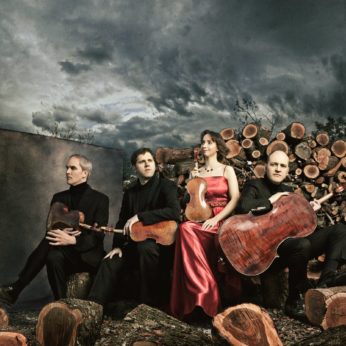Composer: Wolfgang Amadeus Mozart (b. 1756 - d. 1791)
Performance date: 29/06/2013
Venue: St. Brendan’s Church
Composition Year: 1782
Duration: 00:29:55
Recording Engineer: Damian Chennells, RTÉ lyric fm
Instrumentation: 2vn, va, vc
Instrumentation Category:String Quartet
Artists:
Cuarteto Casals (Abel Tomás Realp, Vera Martinez Mehner [violins], Jonathan Brown [viola], Arnau Tomás Realp [cello]) -
[quartet]

This Quartet is the first in
the series of six that were dedicated to his friend and mentor, Joseph Haydn.
It was completed on the last day of 1782, which means it probably predates the
decision on the dedication. He had originally intended to give the series to
the Parisian publisher Sieber, where a dedication to Haydn would not have done
much to promote their sales. The final choice of the Austrian publisher Artaria
was much more in keeping with a dedication to Haydn, who was admired by every
music-lover in
Haydn’s Op.33 set of six quartets had been completed the previous year and
published in the Spring of 1782. There seems little doubt that Mozart’s set was
by way of a reply. The year 1782 was also the period when Mozart undertook his
intensive studies of the fugues by the Bach family, Wilhelm Friedemann’s and
Johann Christian’s as well as Johann Sebastian’s. These studies bore fruit in
the many fugues that Mozart composed and arranged in this period, but with none
of them quite so superbly outrageous as the Finale of this Quartet.
This is one of his most elaborate
works where both his harmonic invention and his control of polyphony are at
their most impressive. The key of G major turns out to lead to some rough
dissonances and fairly gritty music, despite the surface polish. The opening
subject has a sinuous line that readily lends itself to chromatic and
contrapuntal development. Indeed the extended development section is almost
entirely concerned with the possibilities this theme offers. The second subject
has two sections, both bright and airy and full of brilliant dynamic contrasts.
It ends with a cadence that serves as a form of punctuation throughout the
development and the lengthy recapitulation and indeed has the last word in the
coda.
One feature of Haydn’s Russian
Quartets was the increasing complexity of his minuets, which he renamed scherzos.
He did this by calling into question the basic dance structure of the minuet.
Mozart follows Haydn’s example by distorting the dance character of this
minuet, the 3/4 beat keeps jumping the rails in increasingly eccentric ways.
This fascinating exercise greatly extends the scope of this movement, without
in any way compromising its charm. The Trio announces itself with intrusive G
minor chords, which crush every attempt to create delicate threads of melody.
The return of the minuet is a relief after this threatening atmosphere.
first movement. The richly decorated theme is seduced into travelling to the
most obscure and faraway tonalities before returning to more familiar regions.
This is a wonderfully spacious movement, the emotional heart and expressive
climax of the quartet. The Finale is Mozart showing off his mastery of the
deadly serious business of composing fugues by using themes straight out of opera buffa, the archaic notion of the
fugue is made to turn somersaults with themes that could have come straight out
the Seraglio. So the sober four notes
contour of the initial fugal theme quickly turns acrobatic when juxtaposed with
the joyful counter-themes. This brilliant high-wire act of Mozart bringing
together all his learning in a high-spirited finale is the ideally effervescent
conclusion to this remarkable work.
Copyright © 2024 West Cork Music. All rights reserved.
Designed and developed by Matrix Internet